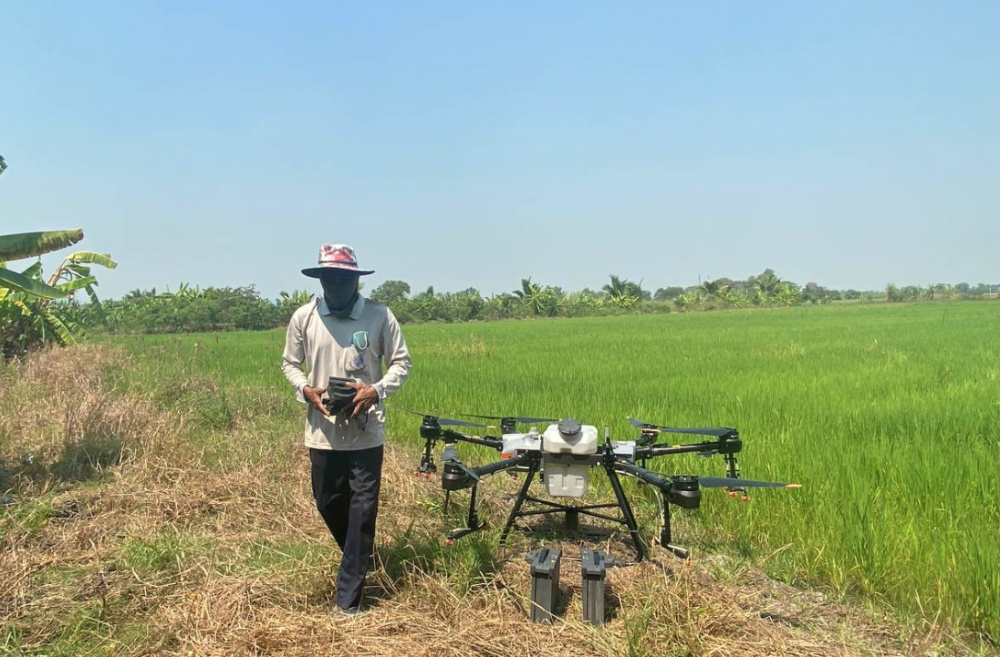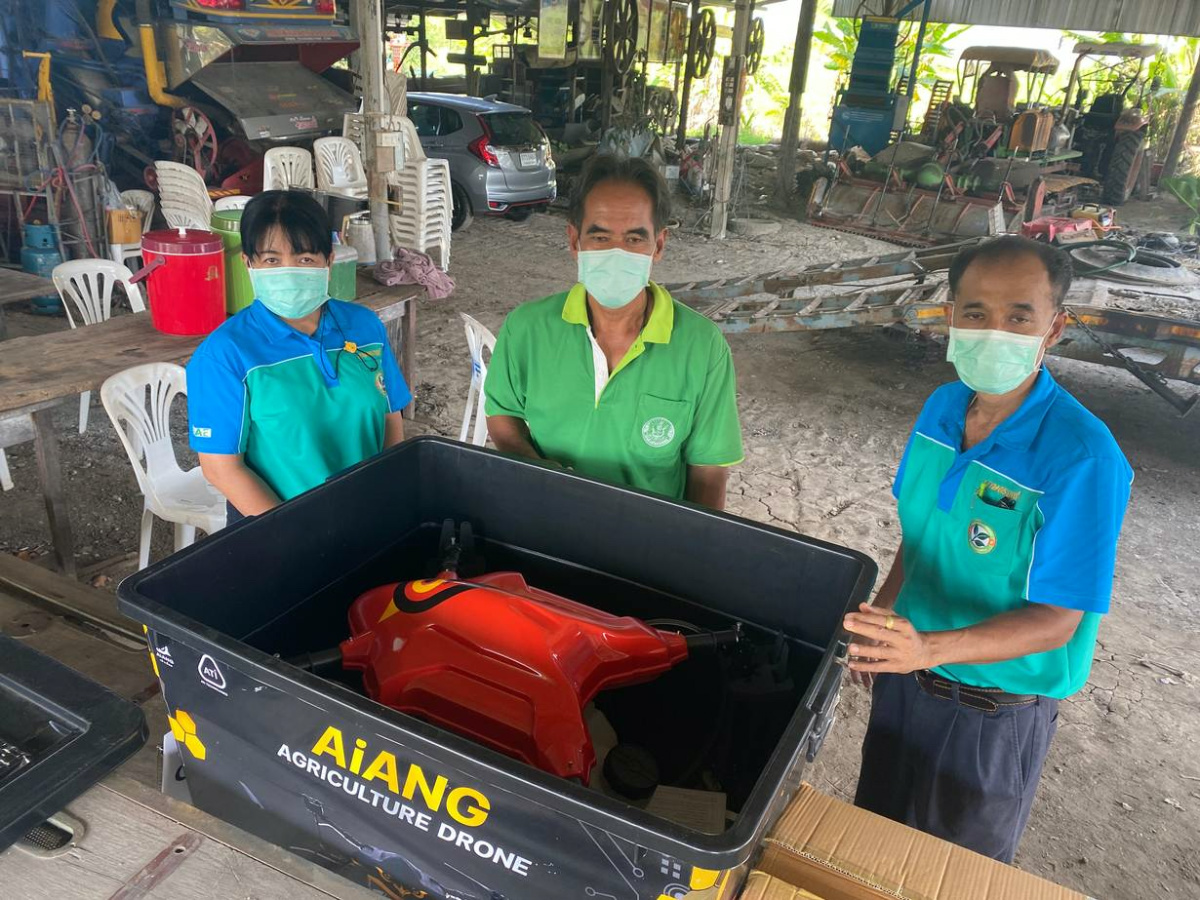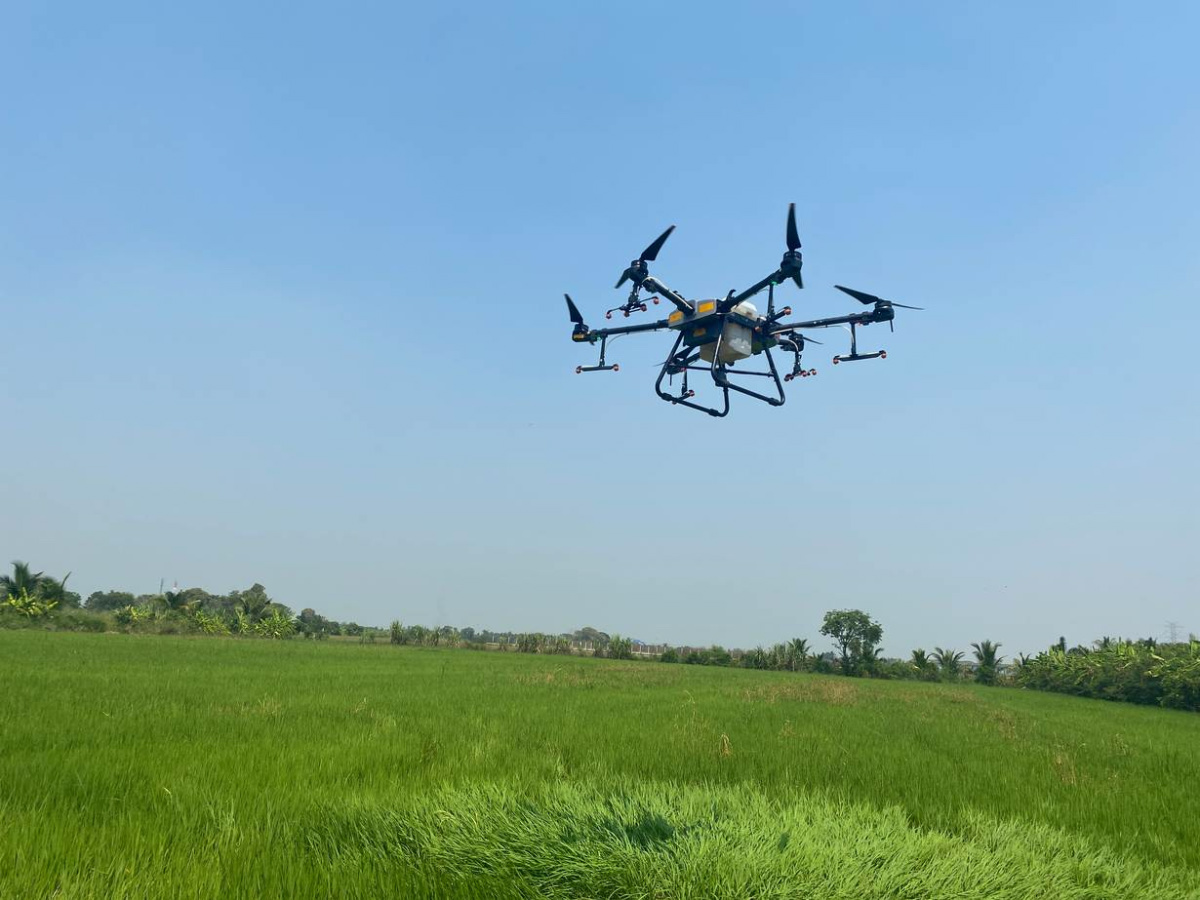
RINA CHANDRAN, of Thomson Reuters Foundation, reports on how falling technology costs, labour shortages are driving popularity of digital tools to improve crop yields, farm incomes in Asia…
Ban Mai, Thailand
Thomson Reuters Foundation
As a child, Manit Boonkhiew watched his grandparents plough their rice farm near Bangkok with water buffaloes, and harvest by hand. His parents switched to tractors and threshers, while he now uses a zippy drone to spray pesticide in his field.
Manit, who grows rice, orchids and fruit trees on about 16 hectares of land in Ban Mai, is part of a community enterprise that recently acquired a drone under a Thai government program to digitise agriculture.

Sayan Thongthep, 52, sets up his agrcultural drone to spray pesticide in a rice farm in Ban Yai, Thailand, on 22nd February. PICTURE: Thomson Reuters Foundation/Rina Chandran.
Drones to plant seeds, and spray pesticide and fertilisers are growing in popularity in the Southeast Asian country as it grapples with a labour shortage that worsened during the coronavirus pandemic, with restrictions on movement of workers.
“Labour is the biggest challenge for us – it’s hard to get, and it’s expensive,” said Manit, 56, a leader of the Ban Mai Community Rice Centre farm that comprises 57 members with nearly 400 acres of land.
“With the drone, we not only save money on labour, we can also be more precise. It’s faster and safer, as we are not exposed to the chemicals, and it can help us deal with climate-change impacts such as less rain more easily.”
– Farmer Manit Boonkhiew
“With the drone, we not only save money on labour, we can also be more precise. It’s faster and safer, as we are not exposed to the chemicals, and it can help us deal with climate-change impacts such as less rain more easily,” he said.
The Ban Mai community is part of a wider transformation of agriculture in Asia Pacific, where artificial intelligence and big data are powering smartphones, robots and drones to improve farming techniques, boost crop yields and incomes.
The trend towards data-based precision agriculture and other digital tools is being driven by demographic changes, technological advances and climate change, according to the Food and Agriculture Organization.
“They help farmers produce more with less water, land, inputs, energy and labour, while protecting biodiversity and reducing carbon emissions,” the FAO said in a report at a regional conference on digitalisation in agriculture this week.
“Farmers can optimise yields and obtain major cost savings, enhanced efficiency, and more profitability,” it said.
But agricultural technology – or agri-tech – also poses risks from job losses to social inequities and data governance concerns. The technologies can be costly and hard to adopt, particularly for women and older farmers, experts said.
“In India, there are far more pressing concerns that the government should be paying attention to,” said Nachiket Udupa with the Alliance for Sustainable and Holistic Agriculture.
“We’ve seen massive farmers’ protests in India on issues like the minimum support price and lack of support from the government. Drones are not the biggest issue for farmers,” he told the Thomson Reuters Foundation.

Farmer Manit Boonkhiew is flanked by local officials as they show an agriculture drone received under a government scheme to digitise agriculture in Ban Yai, Thailand, on 28th February. PICTURE: Thomson Reuters Foundation/Rina Chandran
Worldwide, the rise of cloud computing and AI technologies have popularised the use of big data in numerous applications in agriculture – from irrigation controllers to services that capture and analyse data on the soil, weather and crop yields.
Asia Pacific is one of the fastest growing markets for digital farming information and marketplaces, fintech solutions, and blockchain technologies for food traceability.
But smallholders in Asia largely use only low-cost tools such as digital soil-testing kits and app-based or text-based services for weather forecasting because of cost barriers, skills gaps and regulatory bottlenecks, the FAO said.
Women too, face more constraints in accessing technologies.
In India, the average size of a land holding is less than two hectares, which does not lend itself to much mechanisation or digitisation – which are also expensive for most farmers, said Udupa.
There are about 20 million farmers in India who use some technology, a fraction of the nearly 500 million farmers in the country, said M. Haridas, co-founder of DataVal Analytics, that has an AI-based mobile app to provide real-time crop analysis.
“Data makes farming more democratic – even smallholders can access AI and machine learning to improve yields and returns,” he said.
“The biggest challenges are the lack of devices, lack of internet connectivity and lack of training,” he added.
To improve rural internet connectivity, the FAO’s “digital villages” initiative has teamed up with tech firms such as Microsoft and IBM in 1,000 sites worldwide, including in Nepal, Bangladesh, Fiji, Indonesia, Papua New Guinea and Vietnam.
“The aim is to use technology to advance and improve agriculture, nutrition, health and well-being of citizens, especially rural populations,” said Sridhar Dharmapuri, a senior food safety and nutrition officer at FAO, noting that this is particularly crucial after disruptions from COVID-19.
“As 4G services expand and 5G services are rolled out, the decreasing costs of smartphones and data are accelerating the adoption of digital tools, including among small holders and family farmers, therefore powering further inclusion” he added.

Despite regulatory hurdles and land fragmentation, the Asia-Pacific region is the fastest growing market for agricultural drones, according to the FAO, driven by local providers, falling prices, and rising labour costs.
Governments in the region are using drones, with satellite imagery, for weather forecasts, disaster management and crop insurance, as well as for monitoring and mapping crops strategic for food security, mostly rice.
We rely on our readers to fund Sight's work - become a financial supporter today!
For more information, head to our Subscriber's page.
In India, so-called kisan drones, or farmer drones, are to be used for crop damage assessment and digitisation of land records, which risks excluding women and tillers who are typically not named in land records, said Udupa.
“Land records are a mess in India – so using drones won’t solve the issue,” he said.
“Drones are largely being pushed as a means of greater mechanisation because there is a perception that farm labour is getting relatively expensive. But for the average small or marginal farmers, these technologies are simply unaffordable.”
In Thailand, the state digital economy promotion agency has, since 2020, given individual farmers a 10,000-baht ($US306) grant for agri-tech, while community enterprises get a 300,000-baht grant.
In Ban Mai, a bright orange 10-litre agriculture drone from the agency sits in a black carton, waiting to be used as soon as some farmers get a licence to operate it.
In the meantime, the community has been hiring a drone from one of its members, who bought a 30-litre drone with his savings after battling constant labour shortages on his rice farm.
“A lot of people hire me to spray their farms, because they see how efficient and cost-effective it is,” said Sayan Thongthep, 52.
“I’m going to train my daughter also to operate the drone – it’s a good way to get youngsters interested in farming.”





